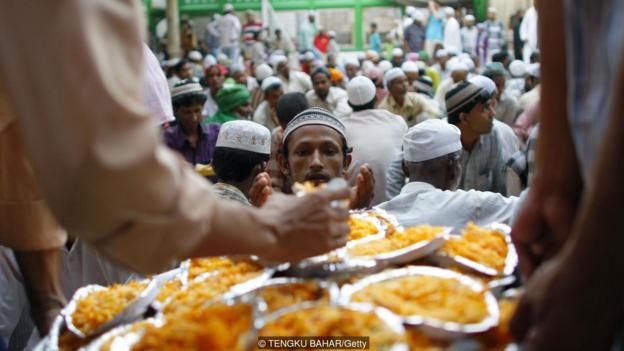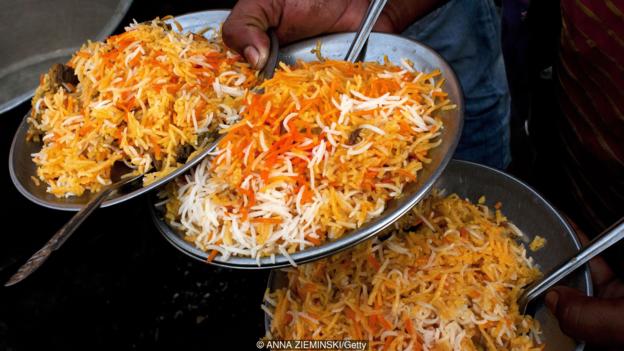Biryani, the centrepiece of countless Indian holidays and weddings – where it regularly upstages the cake – is at the centre of a contentious cultural firestorm.
If India had a national food, one contender up there with rotis, dal or samosas might be the spiced, multi-layered rice dish known as biryani. This rich, celebratory fare was most likely bestowed on the subcontinent by the Persian and Central Asian rulers who also gave India the exquisite Taj Mahal.
Now, biryani, the centrepiece of countless holidays and weddings in India – where it regularly upstages the cake – is at the centre of a cultural firestorm.
Police in parts of Haryana state in northern India have taken the extreme measure of checking dishes of mutton biryani at public eateries to ensure they don’t contain beef. Not only does India’s Hindu majority mostly not eat the meat of this sacred animal, but slaughtering cows is illegal in most of India, including Haryana, where a 2015 law dictates up to 10 years in prison. More than 20 Indian states forbid either cow slaughter, beef eating or both.
“We have been getting lots of complaints that beef is mixed in the biryani in Mewat district so I have ordered the police to physically check the biryani sold in eateries there,” Haryana Cow Service Commission Chairman Bhani Ram Mangla told the BBC World Service’s Amitabha Bhattasali.
Considering India’s incredible diversity – of people and food – sensitivity to such issues is not surprising. Like its bustling markets and heady masalas, India itself is a dizzying jumble of religions, languages, cultures and cuisines.
“Food is a marker of identity, be that ethnic, religious, socio-economic or personal, so humans might be particularly sensitive when that part of their identity is challenged or questioned,†said Carol Helstosky, associate professor of history at the University of Denver.
Take biryani, for example. There are at least as many ways to prepare the dish as there are states in India. In Hyderabad, layers of seasoned meat and saffron-flecked rice are sealed under a lid of dough then steamed, in the most traditional preparation called dum. In Chennai, the dish takes on heat with chilli pepper and acidity with tomatoes. And in Calcutta, a potato-studded biryani is traditionally topped with a boiled egg.

Judging from news reports, peppered with mentions of “biryani warâ€, “communal riots†and “cow vigilantismâ€, food is a source of intense conflict in India.
But talk to the people and you hear a different story.
“This biryani news is just media hype,†said Wahaja Karim, a Bombay transplant living in New Delhi. “Food in India unites people rather than being a source of hatred.â€
That’s how Faisal Siddiqui, a New Delhi-born food-lover now living in the US state of New Jersey, remembers India.
Siddiqui, a Muslim, grew up in the Hindu-majority Lodhi Road neighbourhood of south Delhi, skipping school and playing cricket with Hindu, Muslim and Sikh friends.
He recalled visiting pandals, small roadside tents erected for Sikh saint holidays, which worshippers marked by distributing food, like halwa poori, rich semolina cooked with butter and sugar, served with sweetened fried dough; and chole, savoury chickpeas stewed with onions, potatoes and spices.
“A lot of people – labourers, students, kids, Sikhs, Hindus, Muslims, Christians – pretty much anyone used to visit. Indians love free food,†Siddiqui said, laughing.
His fondest memories, however, are of Bakr Eid, the Muslim religious holiday marked by slaughtering goats in remembrance of Prophet Abraham’s willingness to sacrifice his son as an act of submission to God.
For Siddiqui and his extended family, preparations began a week earlier, when his uncles would bring home six or seven goats, kept on the terrace-like roof, for the children to feed, clean and take care of before the holiday.
“I used to get attached to them,†remembered Siddiqui. “Eid day was tough.â€
On Eid, a butcher would come to the house and slaughter the animals, which were skinned, butchered and portioned, and the meat distributed to family, neighbours and the poor, in accordance with Muslim tradition. The highlight of the day? Dinner.
“Biryani was always dinner on Eid,†said Siddiqui. “That was the centrepiece of Eid.â€

In his home in New Delhi, that meant rice cooked with the freshly slaughtered meat, served with a spicy red-chilli chutney and soothing raita, or yoghurt. Siddiqui and his cousins would unfurl the long tablecloth known as a dastarkhan, set it with plates and await the biryani. If his uncles bumped into Hindu colleagues on their way home from prayers, they would join the feast, along with neighbours, friends and family.
“Everyone would sit together and eat,†said Siddiqui, recollecting how Hindus loved Bakr Eid.
For him, biryani was a food that brought people together.
“Food, for me, was always something uniting. Even if people didn’t eat meat, they would still come and choose the vegetable dishes. But we would always eat at the same table,†he said.

By Husna Haq






